| |
Glossary of Coral Reef Terminology - W
Wahlund effect - a subdivided population contains fewer heterozygotes than predicted despite the fact that all subdivisions are in Hardy-Weinberg equilibrium, i.e., internally subdivided species have more homozygosity than an equivalent fused population would, creating more phenotypically expressed variation |
wake - waves generated in the water by a moving vessel |
walking shark - a small, slender-bodied, bottom-dwelling epaulette shark (Hemiscyllium sp), one of the carpet sharks, that uses its pectoral fins to "walk" across the seafloor |
wall - the reef slope, which may suddenly drop off into deeper water, forming a nearly vertical wall |
Wallace's Line - a hypothetical line which separates the zoogeographical regions of Asia and Australasia. It is named after Alfred Russel Wallace who noticed the apparent boundary during his travels through the East Indies in the 19th Century. The line runs through the Malay Archipelago, between Borneo and the Celebes and Bali and Lombok. West of the line are found mostly species that are related to Asiatic species, to the east mostly species that are related to Australian species |
warning signal - in animal behavior, any visual, acoustic, or chemical signal (stimulus) broadcast by an organism to warn others of its presence; also includes threat signals directed toward an opponent of the same or different species |
wash zone - the depth zone in which sediments are disturbed by wave action near the shoreline |
wastewater - water that is a mixture of water and dissolved or suspended solids carrying wastes from homes, businesses and industries |
wastewater treatment - any of the mechanical or chemical processes used to modify the quality of wastewater in order to make it more compatible or acceptable to humans and the environment |
wastewater treatment plant - a facility containing a series of tanks, screens, filters and other processes by which pollutants are removed from water |
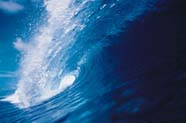
Wave sweeps toward a coastline. (Photo: Copyright Digital Vision Ltd.)
|
water - pure water consists of hydrogen and oxygen, H2O. It is a binary compound that occurs at room temperature as a colorless, odorless, tasteless, transparent liquid which is very slightly compressible. It freezes at 0 degrees C and boils at 100 degrees C. It is the most important natural solvent, and frequently contains impurities, which are mostly removed by distillation |
water column - the water mass between the surface and the bottom |
water mass - a large body of water whose density characteristics are distinct from the surrounding aquatic environment because of inherent temperature or salinity differences |
water pik method - a laboratory technique which uses a water pik to separate tissues from the skeletons of hard corals or remove zooxanthellae from coral polyp tissues |
water pressure - the force per unit area exerted by the weight of water. Each 33 feet of sea water exerts a pressure equivalent to one atmosphere, or 14.7 psi |
water renewal time - an estimate of the time needed to actually renew the water of an atoll lagoon |
water strider - an insect (a bug) in the order Hemiptera. Some species, mostly in the genera Hermatobates and Halobates, are marine inhabitants of mangroves, intertidal coral reef flats, and the water surface near coral and rocky reefs in the Indo-Pacific region; marine species also called "sea skaters" |
water table - the level or depth below the ground that is saturated with water |
water table - the level below the earth's surface at which the ground becomes saturated with water. The water table is set where hydrostatic pressure equals atmospheric pressure; the surface between phreatic water which completely fills voids in the rock and ground air which partially fills higher voids |
water vapor - the water present in the atmosphere in gaseous form. It is the most abundant greenhouse gas |
water vascular system - in echinoderms, a system of internal canals and appendages that are water-filled and functions as a means of locomotion |
watercourse - a natural channel for water |

Angel Falls, Venezuela. This great waterfall contributes to the Oronoco River watershed. Nutrients and minerals from the rainforests and savannas of the Oronoco River basin are transported with the Oronoco current and may effect coral reefs in the southeastern Caribbean. (Photo: Copyright Dr. Anthony R. Picciolo, NOAA)
|
watershed - an area of land that drains downslope to the lowest point. The water moves through a network of subterranean and surface drainage pathways which converge into streams and rivers, eventually reaching an estuary and finally the ocean. Because water moves downstream, any activity that affects the water quality, quanity, or rate of movement at one location can affect locations downstream to the ocean and out to coral reefs |
wave crest - the top of a wave |
wave height - the vertical distance between the crest and adjacent trough of a wave |
wave length - the distance between two successive wave crests or troughs |
wave trough - the low spot between two successive waves |
WCMC Global Coral Disease Database - the World Conservation Monitoring Centre (WCMC) and NOAA maintain the Global Coral Disease Database which is populated with over 2000 records of coral diseases from approximately 155 sources. The occurrence of a disease on a coral species (or genus) was recorded for each location and date on which it was observed. A unique combination of coral species, disease, date, and location therefore constitutes a single record |
weather - temperature, precipitation, and wind speed and direction that occur on a daily basis |
Web Reef Advisory System (WRAS) - the Web Reef Advisory System (WRAS) was developed by ReefBase and Reef Check, in collaboration with the Coastal Resources Center at the University of Rhode Island and the Department of Biological Sciences at the University of Southern California, as "an online application to input, view, and analyze Reef Check survey data. It calculates indicators of how good or bad a shape a particular reef is in, and what the underlying causes may be, based on Reef Check surveys." WRAS allows users to view, analyze, and add data. The file location is: www.reefcheck.org/datamanagement/ |
Weberian apparatus - the four anterior vertebrae and associated tissues in some fishes (catfishes, loaches, minnows, suckers) that connect the gas bladder to the inner ear, conveying pressure changes and sound |
wedge shaped - a form that is thick at one edge and tapered to a thin edge at the other |
weight belt - a belt worn during scuba diving that contains lead weights, either solid masses or as shot in pouches. The weight belt allows a diver to descend in the water column against the forces buoying the diver upwards |
wet collection - a museum collection of specimens that are stored in ethanol, isopropanol, formalin or other liquid preservatives |
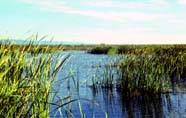
Wetlands provide for valuable nursery areas for many organisms.
|
wetland - an area that, at least periodically, has waterlogged soils or is covered with a relatively shallow layer of water. Bogs, freshwater and saltwater marshes, and freshwater and saltwater swamps are examples of wetlands |
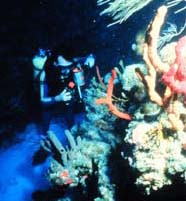
A scientist stands in a sand channel within a reef spur-and-groove zone.
|
white hole - an area along the spur and groove system (zone) where the sand channel widens considerably |
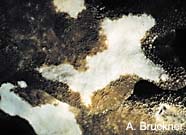
White pox disease is characterized by white circular lesions on the surface of infected colonies (Photo: Dr. A. Bruckner, NOAA)
|
white pox disease - a coral disease characterized by circular lesions with coral tisue degradation on the Caribbean elkhorn coral, Acropora palmata. The pathogen is a bacterium, Serratia marcescen. |
white skeleton - the exposed white calcium carbonate skeleton of a coral colony |
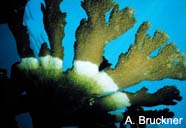
Elkhorn coral populations have suffered widespread declines from white-band disease (Photo: Dr. A. Bruckner, NOAA)
|
white-band disease - a coral disease characterized by complete coral tissue degradation of Caribbean acroporid corals.-Two species of Acroporidae are affected, the elkhorn coral, Acropora palmata, and the staghorn coral, A. cervicornis. The disease exhibits a sharp demarcation between apparently healthy coral tissue and exposed coral skeleton.- These signs are identical to plague, except that white band is acroporid specific (and plague has not been found on acroporids).- Tissue loss usually proceeds- from the base of the colony branch to the tip, although it can begin in the middle of a branch in A. cervicornis. White band disease affects acroporid corals throughout the Caribbean and has decimated populations at a regional scale.The infective agent has not yet been isolated. For more information and illustrations, see: http://www.coral.noaa.gov/coral_disease/white_band.shtml |
whorl - a ring; one turn of a spiral |
wild - living in a natural state; living in nature |
wild type - the form of an organism that occurs most frequently in nature |
wildlife refuge - an area designated for the protection or replenishment of wild animals, within which hunting and fishing are either prohibited or strictly controlled |
wind vane - an instrument used to determine wind direction |
windlass - a winch used to raise a ship's anchor |
windward - refers to the side of an island or reef that faces the prevailing wind |
Windward Passage - a channel between eastern Cuba and western Haiti that connects the Atlantic Ocean with the Caribbean Sea |
Winogradsky column - a glass column with an anaerobic lower zone and an aerobic upper zone, which allows growth of microorgansims under conditions similar to those found in a nutrient-rich body of water.It is a simple device for culturing a large diversity of microorganisms |
work - in physics, the transfer of energy from one object or system to another by applying a force over a distance. The formula for work is (force) x (distance) |
work (taxonomy) - in the International Code of Zoological Nomenclature, any text whether published, unpublished, or carrying a disclaimer containing a name or other information bearing on nomenclature |
work of an animal - results of the activity but not part of the animal itself, e.g., tracks, trails, worm-tubes, borings (but excludes some fossil evidence such as internal molds, external impressions and replacements) |
World Commission on Protected areas (WCPA) - the world's leading global network of protected area specialists.The mission of the WCPA is "to promote the establishment and effective management of a world-wide representative network of terrestrial and marine protected areas, as an integral contribution to the IUCN mission" |
World Conservation Union - the name of the IUCN used since 1990. See IUCN |
World Register of Marine Species (WoRMS) - an authoritative and comprehensive list of names of marine organisms, including information on synonymy. While highest priority goes to valid names, other names in use are included so that this register can serve as a guide to interpret taxonomic literature (www.MarineSpecies.org) |
WorldFish Center - an autonomous, nonprofit organization which was established as an international center in 1977. Its mission is to reduce poverty and hunger by improving fisheries and aquaculture. The Center is an operational entity with programs funded by grants from private foundations and governments. It is governed by an international Board of trustees; its policies are implemented by the Director General. In 1992, the WorldFish Center became a research center of the CGIAR (Consultative Group on International Agricultural Research). The CGIAR is an informal association of more than 60 public and private sector members; formerly known as "ICLARM" |
worm reef - a massive structure composed of clusters of oval, table-like mounds constructed by marine polychaete worms in the family Sabellariide. They consist of all sorts of sediments consolidated by a mucoprotein cement produced by the worm. This reef may start in the intertidal zone and extend into the subtidal zone. Some are in deeper water. Unlike the colorful and ornate coral reefs, worm reefs are drab, monotonous and rounded clusters, mounds and platforms that grow upward and outward from the durable substrate from which their colonies develop. Worm reefs offer several ecological benefits. They provide feeding and browsing grounds for a diverse community of marine organisms and an ideal home for attaching plants, sponges and shelter-seeking animals. Also, unlike coral reefs, worm reefs are not restricted to the tropics |
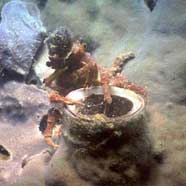
A crab at the opening of a vermetid worm shell, Dendropoma maxima (Photo: Teresa Zubi)
|
worm shell - a snail in the gastropod family Vermetidae. Worm shells are gregarious species forming an intertwining mass of long, white, worm-like tubes, often sunken into a reef substrate. They get their common name of "worm shell" because their shells superficially resemble the shells of some tube-building marine polychaete worms. After a short motile existance, they cement their shell to a hard substrate, and as they grow, the shells may coil or meander over the substrate producing a tube that looks quite like a tube worm. Worm shells are filter-feeders which spin a mucus net to trap floating food particles, such as plankton |
wrack - organic material, usually from dead seagrass or algae that wash up on shorelines |

The wrasse, Coris dorsomacula (Photo: John E. Randall)
|
wrasse - a large family (Labridae) of brightly-colored bony fishes which are common inhabitants of coral reefs. Many have spiny fins, thick lips, and strong teeth. They range in size from about three inches to three meters. Some species of small wrasses are "cleaners," which regulary remove ectoparasites from the skin and gills of larger fishes |
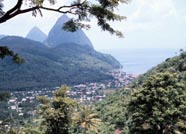
This photograph, used in a poster for WW2BW, suggests the relationships between the forested land, fresh water, the human community, and the sea. The photograph highlights the pitons of St. Lucia in the Caribbean Sea. (Photo: Dr. Anthony R. Picciolo, NOAA)
|
WW2BW (White Water to Blue Water Initiative) - the White Water to Blue Water (WW2BW) Initiative was formulated in 2002 during the World Summit on Sustainable Development. WW2BW responds to the World Summit’s “Oceans” agenda with an integrated approach to sustainable use of water resources. In an effort to address water pollution and scarcity, United States government agencies, including the State Department, NOAA, USAID, as well as the United Nations, governments of the Wider Caribbean Region, and a number of non-governmental organizations have come together to plan and implement programs which will lead to the conservation and sustainable management of both freshwater and coastal marine resources in the Caribbean. WW2BW stimulates partnerships to promote integrated watershed and marine-based ecosystems management in support of sustainable development. Four thematic areas are supported: integrated watershed management, marine ecosystem-based management, sustainable tourism, and environmentally sound marine transportation. The outcome of the WW2BW partnership in the Wider Caribbean may serve as the blueprint for future programs on watershed and marine ecosystem-based management in Africa and the South Pacific |
|
|
|
|

